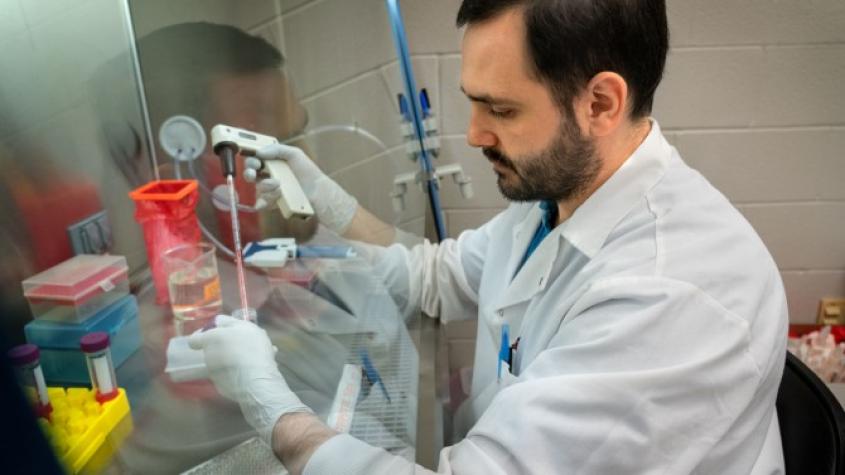CVM COVID-19 working group gears up
When Cornell leaders announced suspension of noncritical research March 15, they made clear that research essential for the understanding and reduction of COVID-19 would continue.
While many researchers have faced a temporary work stoppage, Gary Whittaker, professor of virology in the College of Veterinary Medicine, infectious diseases and epidemiology section chief in the Master of Public Health Program, and an expert on coronaviruses, is leading a working group of core laboratories trying to better understand COVID-19, with the hope of future treatment and containment.
Graduate student Esteban Flores isolates cells while working on antiviral solutions March 18 in Luis Schang’s lab at the Baker Institute for Animal Health.
The group includes the laboratories of Luis Schang, professor of chemical virology at the Baker Institute for Animal Health; Hector Aguilar-Carreno, associate professor of microbiology and immunology; Diego Diel, associate professor of population medicine and diagnostic sciences; and Colin Parrish, professor of virology.
The Research Division will soon be hosting a webpage for Cornell COVID-19 research that will act as a portal for researchers to get information, share funding opportunities and network with others with various expertise.
“We want to streamline the process and get people talking to each other and form teams,” Whittaker said.
Whittaker will be investigating COVID-19’s viral spike protein, a crown-like protein on the virus’s surface that binds with receptors on a host cell and gains entry to deliver the viral genome into the cell. Whittaker has done extensive research on other coronaviruses, including Middle East Respiratory Syndrome and severe acute respiratory syndrome (SARS), which first infected people in 2002. He is particularly interested in how the spike protein is activated to trigger fusion with the host cell.
“There’s a little insertion right at the activation site – four amino acids – which is distinctly different [in COVID-19] from any other SARS-like virus,” he said.
Whittaker also is investigating a broadly acting coronavirus vaccine and other therapeutic approaches based on the coronavirus fusion activation mechanism.
“We want to streamline the process and get people talking to each other and form teams.”
Gary Whittaker
“So if and when the next pandemic hits, we will be ready for it,” he said.
Schang has been working to develop anti-viral agents for other human pathogenic viruses. He has shut down all other research in his lab to specifically focus on COVID-19.
“We try to find things that are common to unrelated viruses,” he said. “We’re interested in small molecules that inhibit many different viruses to test them against COVID-19.”
Aguilar-Carreno will be investigating a COVID-19 vaccine as well anti-viral drug design, while Diel will be developing diagnostic tests for humans and animals.
In addition, Colin Parrish, the John M. Olin Professor of Virology at the Baker Institute, has suspended all work in his laboratory apart from a study on the structure of the COVID-19 spike protein, as well as antibodies that might recognize the spike protein and be protective, he said. He is also working with epidemiological modelers who are collaborating on computer and epidemiological studies aimed at predicting the current and future spread of the virus outbreak in the U.S. and elsewhere.
Said Parrish: “We are lacking information about how the virus is spreading and how many people have been already infected, so we’re trying to get some basic information about the different parameters, and using mathematical modeling to determine the course of the outbreak more clearly.”
By Krishna Ramanujan
Video by John Munson
A version of story originally appeared in the Cornell Chronicle.





